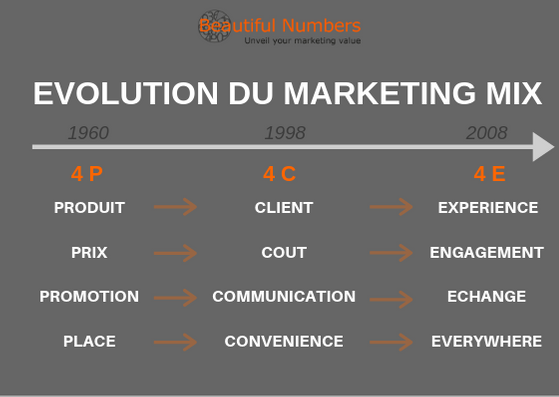Let’s take a look at the Marketing Mix evolution since its creation in 1960.
As a reminder, the realization of your marketing mix is an essential phase in the elaboration of your marketing plan, as it represents the best combination of means to achieve your objectives.

1960 – The 4 P marketing mix
In 1960, Jerome McCarthy proposed the first marketing mix that would become one of the most studied marketing schemes ever.
The 4P marketing mix is the basis of a strategy based above all on the product and its characteristics:
- Product : Companies describe their product, praise their features, qualities and base their communication on: “This product has such characteristics, it is super/better because it does this, has that, allows you to…”
- Prices: Pricing policy is centred on the product/services characteristics . To put it simply, a large number of options = generally a higher price.
- Promotion: Or let’s name it “one way communication”. Companies talk to us: “Buy my product, it’s beautiful, it’s the best”. It is a one-way communication that does not generate any interaction with customers : advertising on TV, radio, through the media, creation of catalogues,….. Promotion was then used by certain type of companies only, as it required an important marketing budget.
- Place: Or Location. Where will products/solutions be sold? At that time, distribution channels were more limited than today. We are talking about “exclusive” distributors at that time, which today seems to be a totally obsolete concept. I personally started my career in a company that had exclusive distribution for France of marine electronic products. A new distribution channel, soon to be called Internet, put an end to the exclusive distribution model.
1993 – The 4 C marketing mix
In 1993, Robert Lauterborn started a revolution by talking about relationship marketing and declared the 4P marketing mix obsolete. In exchange, he offered us the customer centric 4C mix.
- Customer: We no longer talk about the product, but about what it brings to the customer. We change perspective and make the product desirable from the customer’s point of view.
- Cost: Here we refer to the “budget” that the client is willing to commit. Customers then compare service received vs committed budget. Many pricing strategies have been revolutionized by this approach, as customers seek the best offer for the best budget. Prices are then set according to the customers needs + the services offered or characteristics of the product, but no longer only according to the latter.
- Communication: Companies will look forward to having a conversation. You, Mr Customer, I will talk to you and even talk about you, and we will enter into a conversation about your needs and what i can do to fullfill them. At the same time, it is now possible to communicate via new channels much more accessible to all companies: a video published on the net is now much cheaper than a TV ad and also makes it possible to reach a new audience.
- Convenience: Distribution channels are now designed to allow the customer to find services/products easily. We multiply the channels, bypass the exclusive distributors by distributing directly.
2008 – The 4E marketing mix
The 4 E model was introduced in 2008 by Christopher Grave. Find the original pres here.
In this mix, the experience becomes the central point of the strategy. The customer must experience “something”, feel emotions, love the brand, and become its ambassador.
- Experience: We rely on experience. Companies sell their customers an unforgettable experience. Products characteristics are no longer emphasized, we no longer talk about customers need. We talk about the driving experience (you are free and powerful) and no more about the vehicle stability (this vehicle has ABS).
“I learned that people will forget what you said, what you did, but they will never forget what you made them feel” Maya Angelou - Evangelism: We rely on customers to share their experience and recommend our products/solutions. We also often talk about Engagement: it is about engaging our customers and creating a relationship that will make him or her an ambassador for the brand. And we provide value-added content to enable them to become our best sales team.
“Give people an idea so interesting that the audience want to share it” - Exchange: We move from price to cost, then from cost to exchange. Here experts opinions differ. Yesterday I attended an excellent presentation by Miguel Angel TRABADO – who made me want to write this post – who defines the Exchange as follows (I summarize):
Companies proposes the following deal “If you want my products, you’ll have to give me something in exchange” (not just money). Most of the time, they think about our data.
Other specialists see the exchange from another angle : the client is the one making the deal : “If you, as a company, want my money, then you have to promise you can solve my problem, promise a ROI, just promise anything that goes beyond the experience”.
And as Miguel Angel pointed out in this conference, Crowdsourcing or Participatory Production appeared on the marketat that same time of the 4E MM: customers now indicate how the product/service must evolve and what are the expected characteristics. The product/solution is co-constructed. - Everywhere: Products or solutions must be “available” everywhere! Turn on your computer, take out your credit card and place the order.
This last marketing mix requires bringing your company into the digital transformation process. Technology deniers are not big fans of it and denounce many inherent problems.
But honestly, do we really have a choice?
Béatrice Loriot – + 33 6 81 07 34 41 / + 34 680 907 987 – Bloriot@beautifulnumbers.fr
